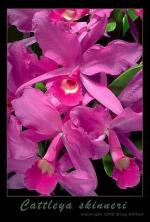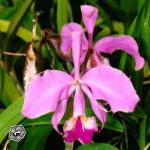|
|
CattleyaFamily: Orchidaceae.
|
|
|
 |
Genus of about 40 species of evergreen, epiphytic orchids from dry coastak areas to altitudes of 7000 ft (2000 m), often found along mountain streams, in Central and South America.
Epiphyptic and epilitic plants with overground rhizomes. Easily bred with genus Laelia, Brassia, Sophronitis. All Cattleya grow in the wild on trees and cliffs. They have usually long spindle-shaped pseudo-bulbs, on the ends of which 1-3 hard leaves are located. The top inflorescence, carrying from 1 to tens of flowers, coming out of the base, covering buds. The blooming of an inflorecence continues 2-3 weeks (sometimes up to 1.5 months). Good in cuttings. |
|
| Growing conditions |
Watering and misting |
Propagation |
| Grow in orchid potting mix in a hanging basket. The inflorescence should remain above the mix when the plant is potted. Cattleyas can withstand hot weather if adequate ventilation and humidity are provided. They do best when the temperature is between 65°F and 75°F in the day and between 58°F. to 62°F. at night. The temperature differential is especially important for flowering. |
Do not water in the winter, but spray regularly. Cattleyas can withstand hot weather if adequate ventilation and humidity are provided. |
Divide when the plant overflows its container, or remove at least 4 backbulbs and pot up separately. |
|
Cattleya aurantiaca |
|
|
|
 |
|
Cattleya bowringiana Veitch. |
|
|
Epiphytic or terrestial with cyllindrical stems, up to 35 cm (10 in), with small bulb-like thick spots at the base. The leaves are long and elliptic.Flowers are 5-7,5 cm (2.5-3 in) in diameter, pink or magenta. Blooms in September-November. Needs a short period of rest in the winter. |
 |
|
Cattleya citrina |
|
|
|
 |
|
Cattleya dowiana |
|
|
|
 |
|
Cattleya georgiana |
|
|
|
 |
|
Cattleya intermedia |
|
|
This is one of the more elegant, white cattleyas. A reliable bloomer producing its flowers in late spring thru summer. Comes from southern Brazil, Uruguay, and Paraguay. Grows intermediate to warm with moderate to bright light. |
 |
|
Cattleya labiata |
|
|
|
 |
|
Cattleya skinneri Batem. |
|
|
Similar to the previous species, but differs in spring blooming. |
 |
|
Cattleya warneri |
|
|
|
 |
|
These materials are freely provided for instructional and educational purposes. Any duplication or publication of text or images herein for commercial gain without explicit written permission of the owner or photographer constitutes breach of trust and violation of copyright.
Copyright © Galka Okhapkina 1998-2026










